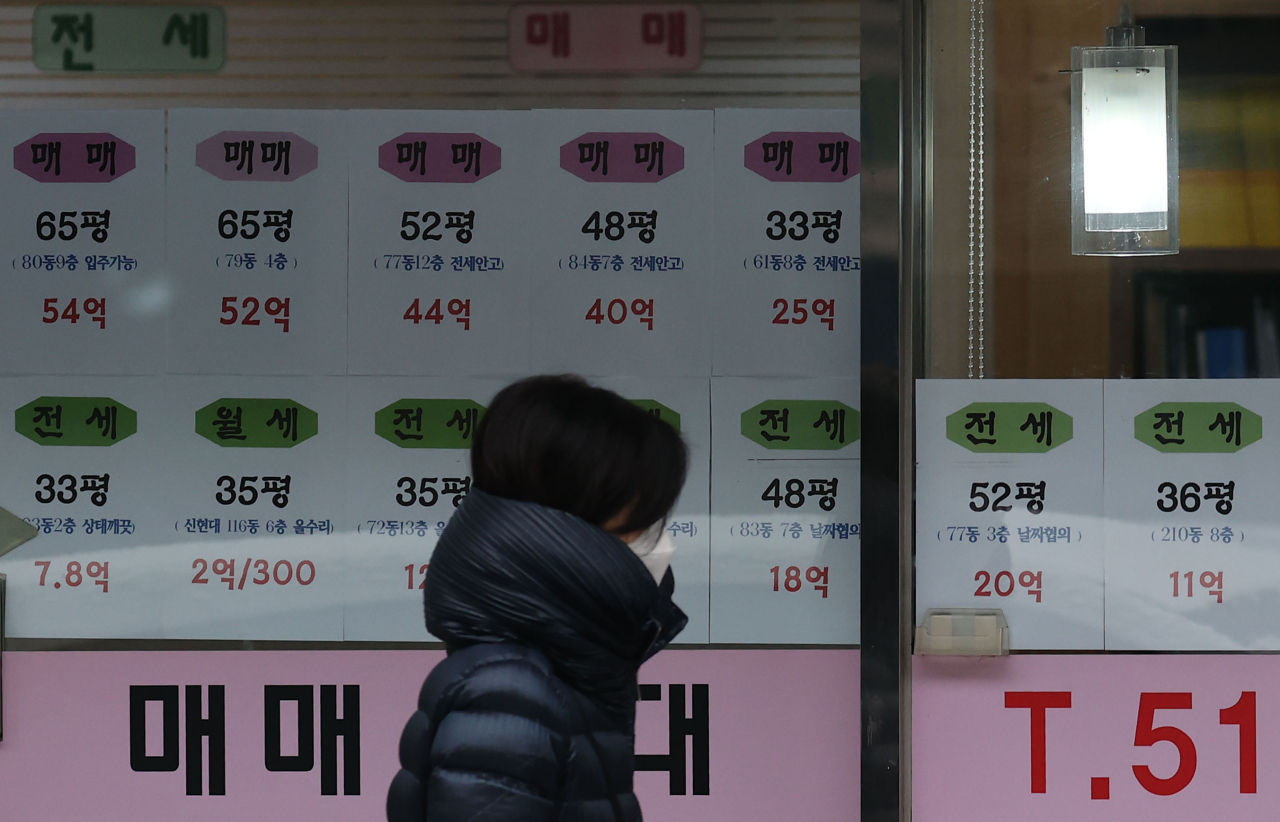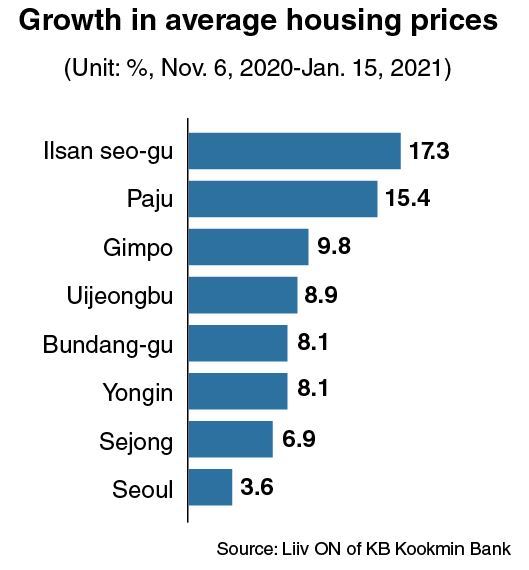[News Focus] Gyeonggi cities lead housing prices growth
In 10 weeks, 17% climb seen in Ilsan, 15% in Paju
By Kim Yon-sePublished : Jan. 21, 2021 - 14:41

SEJONG -- Major cities in Gyeonggi Province, which surrounds Seoul, were found to have led a rise in housing prices in the past 10 weeks, as residents in their 20s and 30s have been snapping up apartments, new data showed.
A younger generation of buyers have been purchasing apartments in high-density residential towns in Gyeonggi Province, as skyrocketing prices in Seoul have pushed them to seek more affordable housing further afield, according to data by KB Kookmin Bank and Naver.com.
The data showed that Gyeonggi’s Goyang and Paju saw the most rapid real estate price increases across the nation in the past two months, with some other cities in the province also recording growth rates far surpassing the nationwide average.
Goyang’s Ilsanseo-gu saw the average trading price of homes surge 17.3 percent from 11.41 million won ($10,300) per 3.3 square meters on Nov. 6 to 13.39 million won ($12,100) on Jan. 15.
This means that the average price of an 84-square-meter house (a popular size among Korean households) in Ilsanseo-gu would cost around 341 million won. A same-sized flat in an apartment building in the same district is much likely to cost far more.

The average price climbed by 13.3 percent in Ilsandong-gu and 9.7 percent in Deogyang-gu over the corresponding 10-week period. Goyang’s price hike far outstripped Seoul’s 3.6 percent and Gyeonggi’s average of 6.3 percent.
“After the government handed down stricter real estate regulations on some other Gyeonggi cities (Gimpo and Paju) in the fourth quarter of last year, home buyers have recently rushed to Ilsan, where the price growth had been meager,” said a real estate agent in the province.
Paju, located north of Goyang, recorded the second-highest growth in housing costs with 15.4 percent, followed by Gimpo with 9.8 percent and Uijeongbu with 8.9 percent.
Among the next rankers were Seongnam’s Bundang-gu with 8.1 percent, Yongin with 8.1 percent, Namyangju with 6.6 percent, Incheon’s Songdo-dong with 6.4 percent and Hanam with 5.7 percent.
Gyeonggi’s Gwacheon, despite a 3.3 percent climb, topped the list in average home prices among the 28 cities and three counties in the province. The city’s average price per 3.3 square meters came to 48.7 million won as of Jan. 15, or around 1.23 billion won for an 84-square-meter unit.
Gwacheon overtook Seoul’s average of 34.4 million won per 3.3 square meters and the capital’s Songpa-gu -- one of the three wealthiest districts in southern Seoul -- of 48.1 million won.
Seoul’s Gangnam-gu maintained the nation’s highest at 61.1 million won, followed by Seocho-gu at 58.2 million won. The two districts saw a growth of 2.8 percent and 2.6 percent, respectively.
Alongside some Gyeonggi cities, two major southeastern metropolitan cities -- Ulsan and Busan -- posted a noteworthy jump of 11.1 percent and 10.8 percent.
Sejong, which reported a historic growth last year, saw its housing price continue to edge up 6.9 percent over the same Nov. 6-Jan. 15 period. Compared to Jan. 3, 2020, the price in the administrative city shot up 73 percent within a year to 20.7 million won per 3.3 square meters.
Earlier last summer, some politicians from the ruling Democratic Party of Korea floated the idea of relocating the administrative capital from Seoul to Sejong, sharply pushing up home and land prices there in the second half of 2020. They have not made any further comments on the issue in recent weeks.
Over the corresponding 10 weeks, a 6.6 percent growth was seen in Daegu, 4.9 percent in Gwangju, 4.6 percent in Daejeon and 2.5 percent on Jeju island.
By Kim Yon-se (kys@heraldcorp.com)






![[From the Scene] Monks, Buddhists hail return of remains of Buddhas](http://res.heraldm.com/phpwas/restmb_idxmake.php?idx=644&simg=/content/image/2024/04/19/20240419050617_0.jpg&u=20240419175937)





![[Graphic News] French bulldog most popular breed in US, Maltese most popular in Korea](http://res.heraldm.com/phpwas/restmb_idxmake.php?idx=644&simg=/content/image/2024/04/18/20240418050864_0.gif&u=)


![[From the Scene] Monks, Buddhists hail return of remains of Buddhas](http://res.heraldm.com/phpwas/restmb_idxmake.php?idx=652&simg=/content/image/2024/04/19/20240419050617_0.jpg&u=20240419175937)

![[KH Explains] Hyundai's full hybrid edge to pay off amid slow transition to pure EVs](http://res.heraldm.com/phpwas/restmb_idxmake.php?idx=652&simg=/content/image/2024/04/18/20240418050645_0.jpg&u=20240419100350)

![[Today’s K-pop] Illit drops debut single remix](http://res.heraldm.com/phpwas/restmb_idxmake.php?idx=642&simg=/content/image/2024/04/19/20240419050612_0.jpg&u=)